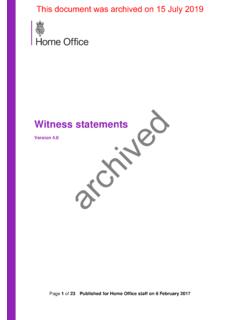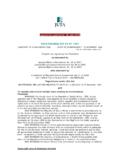Transcription of Evidence in criminal investigations - GOV.UK
1 Page 1 of 39 Published for Home Office staff on 06 July 2020 Evidence in criminal investigations This guidance is based on the criminal Justice Act 2003 and the Police and criminal Evidence Act 1984 Version Page 2 of 39 Published for Home Office staff on 06 July 2020 Contents Contents .. 2 About this guidance .. 4 Contacts .. 4 Publication .. 4 Changes from last version of this guidance .. 4 Definition of Evidence .. 5 Definition of an exhibit .. 5 Admissibility of Evidence .. 7 The res gestae rule .. 8 Classifications of Evidence .. 10 Direct Evidence .. 11 Circumstantial Evidence .. 12 Primary, secondary and forensic Evidence .. 13 Definition of primary Evidence .. 13 Definition of secondary Evidence .. 13 Forensic 13 Expert Evidence .. 14 Forms of Evidence in court.
2 16 Testimony and real Evidence .. 17 Testimony .. 17 Real Evidence .. 17 Hearsay .. 18 Defendant s bad character .. 20 Evidence of bad character: gateways (d) and (g) .. 23 Gateway (d) .. 23 Gateway (g) .. 23 Confession: admissibility .. 25 Confession: oppression, unreliability and unfair Evidence .. 27 Oppression .. 27 Unreliability .. 27 Unfair Evidence .. 28 Documentary Evidence , business documents and schedules .. 29 Documentary Evidence .. 29 Business documents .. 30 Page 3 of 39 Published for Home Office staff on 06 July 2020 Schedules .. 30 Chain of Evidence .. 32 Why you need to show the chain of Evidence .. 34 Charging decisions and disclosure of Evidence .. 35 The decision to charge .. 35 Disclosure of Evidence .. 35 Retaining Evidence .. 37 Lengths of retention .. 38 Page 4 of 39 Published for Home Office staff on 06 July 2020 About this guidance This guidance tells criminal investigators in Immigration Enforcement (IE) and suitably trained and accredited criminal investigators within the Home Office about Evidence and how they must deal with it during their investigation .
3 The guidance contains information on: a definition of Evidence classifications and forms of Evidence admissibility exclusions, including hearsay Evidence of bad character disclosure and retaining Evidence The Home Office has a duty to safeguard vulnerable people and promote the welfare of children for more information see: Vulnerable people and children. criminal Investigators in Immigration Enforcement must be aware of their obligations under the General Data Protection Regulation (GDPR) and the complementary Law Enforcement Directive (LED) domestic legislation via the Data Protection Act 2018 see: Data protection changes (GDPR and Data Protection Act 2018) Contacts If you have any questions about the guidance and your line manager cannot help you or you think that the guidance has factual errors then email the CFI Operational Guidance Team.
4 If you notice any formatting errors in this guidance (broken links, spelling mistakes and so on) or have any comments about the layout or navigability of the guidance then you can email the Guidance Rules and Forms team. Publication Below is information on when this version of the guidance was published: version published for Home Office staff on 06 July 2020 Changes from last version of this guidance minor housekeeping updated links Related content Contents Page 5 of 39 Published for Home Office staff on 06 July 2020 Definition of Evidence This section tells criminal investigators in Immigration Enforcement (IE) and suitably trained and accredited criminal investigators within the Home Office about the definition of Evidence . If you look up a definition of Evidence you will find many variations, but they all basically say Evidence : is information given to the court and the jury to help them decide if a crime has been committed or not tends to prove the truth or probability of truth about a fact put before the court and jury In court, items of Evidence are referred to as material.
5 There are national occupational standards for investigators dealing with Evidence . You must follow this guidance to help you to meet those standards. Definition of an exhibit An exhibit is a document or other item shown to a witness and referred to by the witness in Evidence . See: CPS Definition of Exhibits. In accordance with common law it is within the power of, and is the duty of, constables to retain for use in court things which may be Evidence of crime, and which have come into possession of constables without wrong on their part. (R v Lushington quote from CPS website). Under the Code of Practice issued under Part 2 of the criminal Procedure and investigations Act 1996 , any police officer investigating alleged crimes has a duty to record and retain material which may be relevant to the investigation .
6 As a general rule, the courts entrust the prosecution with the exhibits pending trial and after committal. The duty of the prosecution is: to take proper care to preserve the exhibits, safe from loss or damage to co-operate with the defence in order to allow them reasonable access to the exhibits for the purpose of inspection and examination to produce the exhibits at trial The police, immigration enforcement and other law enforcement agencies will retain all original exhibits unless it is absolutely essential for the Crown Prosecution Service to accept them. For further information see: criminal Justice Act 2003 Page 6 of 39 Published for Home Office staff on 06 July 2020 CPS Definition of Exhibits Related content Contents Page 7 of 39 Published for Home Office staff on 06 July 2020 Admissibility of Evidence This section tells criminal investigators in Immigration Enforcement (IE) and suitably trained and accredited criminal investigators within the Home Office about when Evidence is admissible (allowed to be used) in court and when it can be excluded.
7 You can only present Evidence in court if it: has been produced by a witness in the form of a statement is under oath For more information on witness statements, see Witness Statements in Civil Procedure Rules Part 32. There are strict rules that govern whether a piece of Evidence is admissible in court. To make sure it is a fair trial, the court can decide whether: a piece of Evidence is admissible to exclude it The court has the power to exclude Evidence , even though it may be admissible, if they feel it is too prejudicial (unfairly biased against the defendant). The court also has extra powers to do with Evidence obtained by confession. The court s power to exclude Evidence comes largely from: Sec 78 of PACE common law Sec 76(2) of PACE, in relation to confessions Depending on where you are working you must follow the provisions on admissibility in line with: PACE England and Wales PACE Northern Ireland Order 1989 The admissibility of bad character and hearsay Evidence is outlined in Chapter 1of the criminal Justice Act 2003 For Evidence to be acceptable it must meet all the criteria in this table: Criteria Definition Probative It: must have value to the case must be credible Page 8 of 39 Published for Home Office staff on 06 July 2020 Criteria Definition can be excluded if it has low probative value Not prejudicial It.
8 Must be factual and impartial can be excluded if the court feels it is too prejudicial towards the defendant Relevant It must: make the matter that requires proof more or less probable help to prove the guilt and innocence of the defendant Accurate It describes facts given in court as accurately as possible to assist the court in deciding what is true. Remember, how you present your Evidence can affect how the court views your Evidence Coherent You must present your Evidence in court in a way that: makes sense to the court is easy to understand, which is often: o chronological (in the order it happened) o in full detail Provable Your case must be capable of proof, unless the law provides otherwise, for example it may sometimes allow an assumption to be made. The res gestae rule The res gestae (things done) rule allows an event to be put into context.
9 If an event is described on its own without the surrounding circumstances then it may not make sense, so it is for the judge to decide whether: the court allows a witness to state facts with reasonable fullness and in context so that they make sense to use this rule to allow Evidence , even though it may: o not be probative o be hearsay For more information on res gestae and the admissibility of Evidence in court, see: Page 9 of 39 Published for Home Office staff on 06 July 2020 College of Policing guidance for res gestae PACE England and Wales PACE Northern Ireland Order 1989 Related content Contents Page 10 of 39 Published for Home Office staff on 06 July 2020 Classifications of Evidence This section tells criminal investigators in Immigration Enforcement (IE) and suitably trained and accredited criminal investigators within the Home Office about the different classes of Evidence they may come across when conducting an investigation .
10 The classes of Evidence you are likely to come across are: direct Evidence circumstantial Evidence primary and secondary Evidence forensic Evidence expert Evidence For details of the above, see: College of Policing guidance for Circumstantial Evidence CPS guidance for Exhibits College of Policing guidance for Forensics CPS guidance for Expert Evidence Related content Contents Page 11 of 39 Published for Home Office staff on 06 July 2020 Direct Evidence This section tells criminal investigators in Immigration Enforcement (IE) and suitably trained and accredited criminal investigators within the Home Office about direct Evidence and how it can be used in court. Direct Evidence is Evidence that is known personally to the witness because they have: personal experience through their senses, for example something they personally: o saw o heard o touched When hearing direct Evidence , the court and the jury: must be able to reach a decision on the information given alone are not required to make any assumptions about facts before them The only thing the court and jury have to consider is, if they believe the person giving the Evidence or not.












